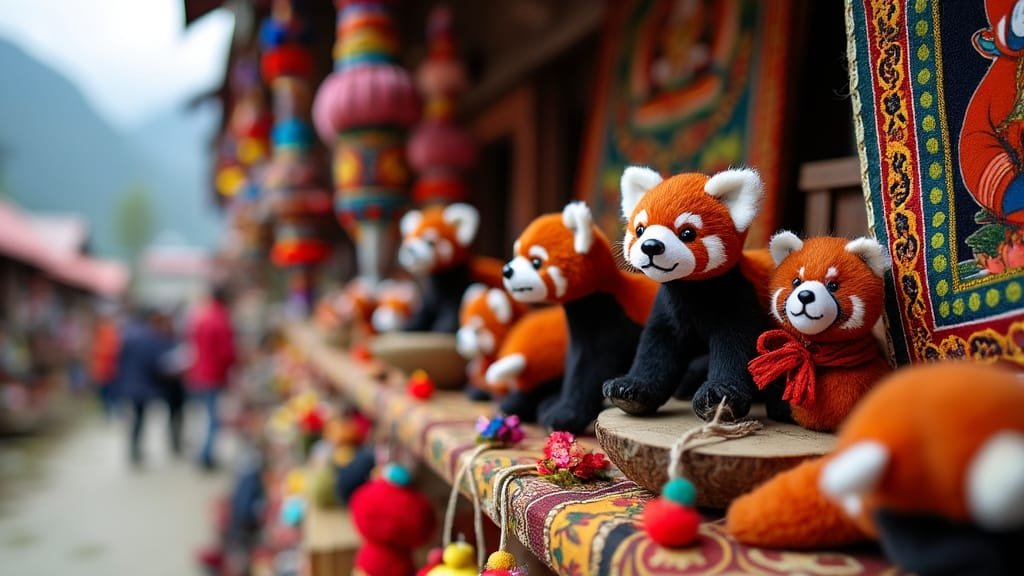Introduction
The red panda holds a unique place in Nepal’s local art and handicraft traditions, celebrated by artisans who reflect its cultural and ecological significance. As an endangered species native to the Himalayan region, the red panda has become a popular motif in Nepalese art, symbolizing both natural beauty and conservation awareness
This article explores the ways in which red pandas are depicted across various art forms, from traditional Thangka paintings to carved wooden figures and woolen crafts. By understanding the role of red panda-themed art in Nepal, we uncover the cultural, economic, and environmental impacts of these representations on local communities and tourists alike
The Cultural Significance of the Red Panda in Nepali Art
In Nepal, the red panda is not only an iconic species but also a symbol embedded with deep cultural meaning. This elusive and gentle animal is revered by local communities, particularly those residing in the eastern Himalayan regions where the red panda is found in the wild
As a symbol of the natural beauty and biodiversity of the Himalayas, the red panda represents the delicate balance of life in the mountains, resonating with the themes of harmony and interconnectedness in Nepalese culture. As a result, the red panda has become a common motif in art and handicrafts, capturing both its cultural and ecological importance
Symbolic Meanings in Local Folklore
In Nepali folklore, the red panda is often viewed as a guardian of the forest, embodying qualities of protection and guardianship. Some tales describe the red panda as a spirit animal that watches over Himalayan forests, promoting respect for nature among local communities
This reverence is reflected in the way artists depict red pandas in traditional art forms, where they are often shown in serene or peaceful poses, surrounded by lush forests or other symbolic elements, such as clouds or mountains
The red panda’s role as a forest guardian reinforces its status as a symbol of environmental awareness and respect for wildlife
The Red Panda as a Cultural Icon in Nepal
For many people in Nepal, the red panda serves as a cultural icon that represents the unique biodiversity of their country
Its status as a rare and endangered species has made it a symbol of conservation efforts, encouraging both locals and visitors to take part in preserving Nepal’s natural heritage
Artisans incorporate red panda imagery into their works not only to celebrate the animal but also to raise awareness about its endangered status. This approach aligns with cultural values that emphasize harmony with nature and the protection of Nepal’s rich wildlife
In addition to its environmental symbolism, the red panda also represents gentleness and peace, qualities highly regarded in Nepali culture. Its quiet and elusive nature has led people to view it as a symbol of tranquility, making it a popular motif in art that aims to evoke a sense of calm and connection to nature
This cultural perception of the red panda as a peaceful creature is frequently captured in handicrafts, where artisans depict the red panda in serene and tranquil poses
Role of Red Pandas in Traditional Nepali Beliefs
Traditional beliefs in some Nepalese communities consider certain animals to be harbingers of good fortune or protectors of the land, and the red panda is one such revered creature. While it may not be as widely known as the snow leopard in terms of symbolic power, the red panda holds a special place in certain communities, particularly among indigenous groups who live near red panda habitats
Some artisans incorporate these beliefs into their work by infusing red panda representations with elements associated with blessings or prosperity, such as lotus flowers or symbols of good luck
The inclusion of red pandas in art reflects a deep respect for this animal and acknowledges its role in maintaining the natural balance. For these communities, depicting red pandas in art forms serves as a reminder of the importance of preserving this gentle animal’s habitat and the overall ecosystem
This connection between red pandas and traditional beliefs strengthens their significance in Nepali culture, highlighting their role as both a cultural and environmental icon
Traditional Handicrafts Featuring Red Panda Motifs
The artistry of Nepal’s local handicrafts reflects the country’s deep connection to its wildlife, with the red panda often featured in a range of handmade items that showcase the skills of Nepali artisans
These crafts not only celebrate the red panda’s beauty but also promote conservation by raising awareness of its endangered status. Through materials like wool, wood, and natural dyes, artisans create red panda-themed crafts that appeal to both locals and tourists, blending cultural heritage with environmental advocacy
Popular Materials Used in Red Panda Crafts
Nepali artisans traditionally use materials sourced from the local environment, creating handicrafts that are both eco-friendly and authentic. Wool is one of the most popular materials, particularly in the Himalayan regions, where red panda-themed hats, scarves, and plush toys are crafted by hand
These woolen items are often dyed with natural colors, adding a soft, earthy appearance that complements the red panda’s natural beauty. The craftsmanship of these woolen items reflects the warmth and softness associated with the red panda, appealing to both children and adults
In addition to wool, artisans use wood to create detailed red panda figurines and ornaments. Hand-carved wooden red pandas are commonly found in Nepali markets, where skilled woodworkers intricately carve these animals to highlight their distinct features, such as their bushy tails and unique facial markings
These figurines are often sold to tourists and serve as keepsakes that embody Nepal’s dedication to wildlife preservation and craftsmanship
Carved Figurines and Decorative Art
Hand-carved red panda figurines are among the most popular handicrafts, showcasing the artistic skill of Nepali woodworkers who bring the red panda to life with intricate detailing
These figurines are often crafted from locally sourced wood, including sal and cedar, which are durable and easy to carve. Artisans may also add paint or natural dyes to emphasize the red panda’s distinctive coloring, using subtle brushstrokes to create realistic patterns on the wood
Beyond figurines, red panda motifs also appear in decorative art pieces, such as wall hangings and relief carvings. In these items, red pandas are often depicted amidst forest scenes, symbolizing their habitat in the Himalayan forests
Artisans sometimes incorporate leaves, trees, and other forest elements into the design, creating a dynamic representation of the red panda’s natural surroundings. These decorative art pieces serve as both cultural artifacts and visual reminders of the importance of preserving Nepal’s rich biodiversity
Woolen and Textile Crafts of Red Pandas
In the high-altitude regions of Nepal, woolen crafts are a common sight, and red panda-themed items are especially popular. Local women’s cooperatives and community groups often make woolen red panda hats, scarves, and toys that capture the animal’s distinct appearance
These textiles are crafted with great attention to detail, with artisans often adding features like round ears and bushy tails to create a whimsical yet lifelike look. Each piece is handmade, which means no two items are exactly alike, adding to their charm and uniqueness
These woolen items not only provide income to local artisans but also promote awareness of the red panda among buyers. For example, plush red pandas crafted from wool are frequently sold as souvenirs to tourists, who take home a piece of Nepal’s natural heritage while supporting local economies
Additionally, some cooperatives donate a portion of the proceeds from red panda-themed crafts to conservation organizations, furthering the effort to protect this endangered species
Red Pandas in Nepali Thangka and Contemporary Art
In Nepal, the red panda has found its place not only in traditional handicrafts but also in revered Thangka paintings and modern art forms
Thangka painting, a centuries-old Buddhist art form, is renowned for its intricate and symbolic depictions of deities, animals, and natural elements, including local wildlife like the red panda
Additionally, modern Nepali artists increasingly incorporate red panda imagery into their work, blending conservation themes with contemporary styles that appeal to a broader audience
Depictions in Thangka Painting Styles
Thangka paintings, traditionally used as aids for meditation and religious storytelling, often incorporate elements of nature to convey themes of harmony and interconnectedness
In recent years, Thangka artists have started to include red pandas within their compositions, especially in pieces focused on environmental harmony and biodiversity
These red panda depictions are highly stylized, emphasizing the animal’s distinct features, such as its round face and bushy tail, while integrating it into the intricate, colorful patterns that define Thangka art
Artists may place red pandas alongside other Himalayan animals like snow leopards and yaks, creating a visual representation of the region’s diverse wildlife. This approach serves as both a cultural homage to the biodiversity of Nepal and a call for environmental stewardship, as the red panda’s inclusion in Thangka art underscores its role within the ecosystem
By using a revered art form to depict red pandas, Thangka artists can promote both cultural heritage and conservation awareness
Influence of Red Panda Imagery on Modern Artists
Modern Nepali artists are increasingly inspired by the red panda, using it as a central theme in their work to explore themes of conservation and cultural identity
In paintings, murals, and sculptures, contemporary artists depict red pandas with a blend of traditional symbolism and modern artistic techniques, often highlighting the animal’s endangered status and the need for conservation. These artworks are sometimes displayed in public spaces, creating a visual reminder of the red panda’s plight and inviting the local community to engage with wildlife protection efforts
For example, urban mural projects in cities like Kathmandu have featured red pandas, combining traditional motifs with bold, modern aesthetics to raise awareness about endangered species
By placing red pandas in public art, modern artists not only celebrate this beloved animal but also make a powerful statement about Nepal’s commitment to conservation, encouraging residents and tourists alike to support wildlife preservation
Red Pandas as Symbols in Conservation Art
Red pandas have also become a prominent symbol in Nepali conservation art, with artists using their work to promote awareness of environmental challenges. Conservation-focused art pieces often depict red pandas in scenes that reflect the impact of habitat loss and climate change on Himalayan wildlife
These pieces serve as educational tools, bringing attention to the environmental pressures affecting red pandas and inspiring viewers to consider how they can contribute to conservation efforts
Some conservation art exhibitions feature red panda-themed artwork as a way to raise funds for wildlife protection initiatives, with proceeds often donated to organizations dedicated to preserving red panda habitats. Through this approach, Nepali artists merge art with activism, using red panda imagery as a vehicle to communicate the urgent need for sustainable practices and wildlife protection in the region
These conservation-focused art pieces contribute to a growing cultural movement that prioritizes the protection of Nepal’s natural heritage
Tourism and Economic Impact of Red Panda Art
Red panda-themed art and handicrafts play an essential role in Nepal’s tourism economy, attracting both local buyers and international visitors interested in supporting eco-friendly products. From marketplaces to specialty shops near popular tourist destinations, red panda items are widely available as souvenirs that represent the country’s cultural and natural heritage
These products not only boost local economies but also help raise awareness about conservation, as many artisans and shops donate portions of their profits to wildlife preservation efforts
Appeal of Red Panda-Themed Souvenirs to Tourists
Red panda-themed souvenirs are highly popular among tourists who visit Nepal, as they offer a unique memento that connects them to the country’s biodiversity
Items like plush toys, wooden carvings, and Thangka paintings featuring red pandas are widely sought after by visitors drawn to Nepal’s rich wildlife. These souvenirs provide a tangible connection to the landscapes and species that make Nepal unique, allowing tourists to take home a piece of the country’s natural beauty
The red panda’s status as an endangered species further enhances the appeal of these items, as many tourists are motivated by a desire to support conservation
According to a 2019 study by Gurung and colleagues, wildlife-themed souvenirs in Nepal generate significant revenue for local artisans, with red panda items among the most popular choices. This popularity highlights the importance of red panda-themed crafts not only as cultural items but also as symbols of environmental awareness, aligning with the values of eco-conscious travelers
Local Artisans and Community Benefits
The production of red panda-themed art supports numerous local artisans and small businesses in Nepal, especially in rural areas near red panda habitats. For many artisans, crafting these items provides a sustainable source of income, helping them support their families while also promoting their cultural heritage
Community-based initiatives, such as women’s cooperatives, often focus on producing handmade red panda crafts, from woolen scarves to hand-carved figurines. These initiatives empower artisans, particularly women, by providing economic opportunities and a platform to showcase their skills
By creating jobs and encouraging the use of local materials, the demand for red panda-themed items helps stimulate economic growth in these communities
Some initiatives also incorporate educational components, teaching artisans about the importance of sustainable practices and wildlife conservation
This approach not only benefits the artisans but also fosters a community-wide commitment to preserving the red panda’s natural habitat, creating a cycle of positive impact that supports both the economy and the environment
Red Panda Art and Handicrafts in Nepali Markets
Red panda-themed items are widely available in Nepali markets, particularly in tourist hubs like Kathmandu, Pokhara, and areas near popular trekking routes
In these markets, visitors can find a variety of handcrafted red panda items, from small wooden figurines to elaborate Thangka paintings. These markets are vibrant centers of cultural exchange, where artisans can share the stories behind their work, helping buyers understand the connection between their purchase and Nepal’s natural heritage
The presence of red panda-themed art in these markets also raises awareness about the animal’s endangered status among both tourists and local buyers. Many shops display informational signs about red pandas and conservation efforts, creating an educational experience alongside the shopping process
This aspect not only enhances the value of the purchase for the buyer but also reinforces the importance of supporting conservation-oriented products. As a result, Nepali markets have become platforms where cultural heritage and environmental advocacy intersect, promoting sustainable tourism that benefits both local communities and Nepal’s rich biodiversity
Conclusion
The representation of red pandas in Nepali art and handicrafts exemplifies the deep connection between cultural heritage, environmental awareness, and economic empowerment
Through a variety of traditional and contemporary mediums—including Thangka paintings, wooden carvings, and woolen crafts—Nepali artisans celebrate the red panda as both an artistic subject and a symbol of conservation
These creations not only appeal to tourists and collectors but also contribute to meaningful economic growth within local communities, providing sustainable income opportunities for artisans, particularly in rural areas
Red panda-themed art promotes awareness of the species’ endangered status, engaging both locals and visitors in Nepal’s conservation story. By purchasing these items, tourists contribute to a cycle of positive impact that supports local economies and raises funds for red panda habitat preservation efforts
As Nepal’s artists continue to blend cultural expression with environmental advocacy, red panda-themed art will remain a vibrant part of both Nepal’s identity and its dedication to protecting its unique wildlife









